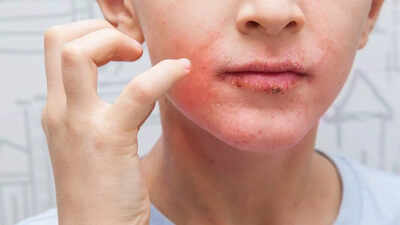ARTICLE AD BOX

The monsoon season brings relief from scorching heat and adds a refreshing charm to the surroundings. However, the damp and humid weather can trigger skin problems in children, particularly rashes.
These rashes often appear as red patches, small bumps, or itchy spots, causing discomfort and distress for your little ones. Common causes include fungal or bacterial infections, allergies, excessive sweating, and even insect bites. Acting promptly with gentle, natural remedies can help soothe irritation, prevent infections, and keep your child’s skin healthy throughout the rainy season.
Causes of skin rashes in children during monsoon
Several factors contribute to rashes in children during the wet season:
- Fungal Infections: Warm, moist areas of the body, such as skin folds, become ideal breeding grounds for fungi.
- Bacterial Infections: Open cuts or scratches can easily get infected in humid conditions, leading to redness and swelling.
- Heat Rash (Prickly Heat): Humidity traps sweat in the pores, causing tiny, itchy red bumps on the skin.
- Allergic Reactions: Some children may react to certain fabrics, detergents, or insect bites, leading to irritation and rashes.
Understanding the root cause is crucial, as this helps in choosing the right remedy and preventing further discomfort.
Natural remedies for monsoon skin rashes
Here are seven effective home remedies to manage and prevent rashes in children during the rainy season:
Neem water bath
Neem is widely known for its antibacterial and antifungal properties. Boil a handful of fresh neem leaves in water and allow it to cool. After your child’s regular bath, use this neem-infused water as a final rinse. It helps soothe irritation, reduces redness, and protects against infections naturally.
Aloe Vera Gel
Aloe vera has cooling, anti-inflammatory, and healing properties that make it ideal for rashes.
Apply fresh aloe vera gel directly on the affected areas twice a day. It reduces itching, speeds up healing, and keeps the skin moisturized without causing any side effects.
Coconut oil massage
Virgin coconut oil is not only a natural moisturizer but also has antifungal properties. Gently massage a thin layer of coconut oil on your child’s skin before bedtime. This helps maintain hydration, prevents dryness, and can protect against fungal infections that are common during humid weather.
Oatmeal bath
Oatmeal has soothing properties that can reduce itching and inflammation. Add 1–2 cups of finely powdered oatmeal to lukewarm bathwater and let your child soak for 10–15 minutes. This simple remedy can calm irritated skin and provide immediate relief from discomfort.
Turmeric paste
Turmeric contains natural anti-inflammatory and antimicrobial compounds. Mix turmeric powder with water or coconut oil to create a smooth paste and apply it to inflamed areas.
Leave it on for 10–15 minutes before rinsing off. Regular use can help heal rashes faster and prevent infection.
Loose, cotton clothing
Tight or synthetic fabrics can trap sweat and worsen rashes. Dress your child in soft, breathable cotton clothes to reduce irritation and allow the skin to breathe. Avoid polyester or other synthetic fabrics during humid weather to prevent additional discomfort.
Keep skin dry
Moisture can encourage fungal and bacterial growth. After baths, swimming, or outdoor play, gently pat the skin dry, especially in folds such as armpits, groin, and behind the knees.
Keeping the skin dry is essential for preventing rashes from worsening.
Prevention tips for monsoon skin rashes
Preventing rashes is always better than treating them. Some simple precautions include:
- Changing wet clothes immediately after rain or sweating
- Using mild, fragrance-free soaps and detergents
- Keeping your child’s nails short to prevent scratching
- Regularly washing and drying bedding and clothes to avoid bacterial or fungal growth
Most minor rashes in children respond well to home care, but it is important to seek medical attention when necessary. If a rash appears suddenly or continues to worsen despite home remedies, or if there is pus, swelling, or other signs of infection, a doctor should be consulted.
Additionally, if your child experiences significant pain or discomfort, or if the rash does not improve after three to four days of consistent home treatment, professional evaluation is recommended.
Prompt medical care can help prevent complications and ensure the rash heals properly.By combining preventive measures with these natural remedies, parents can effectively manage and reduce the occurrence of monsoon rashes, keeping children comfortable and healthy during the rainy season.Also Read: 5 common mistakes older women make that worsen hair loss



.png)
.png)
.png)
















 6 hours ago
3
6 hours ago
3









 English (US) ·
English (US) ·